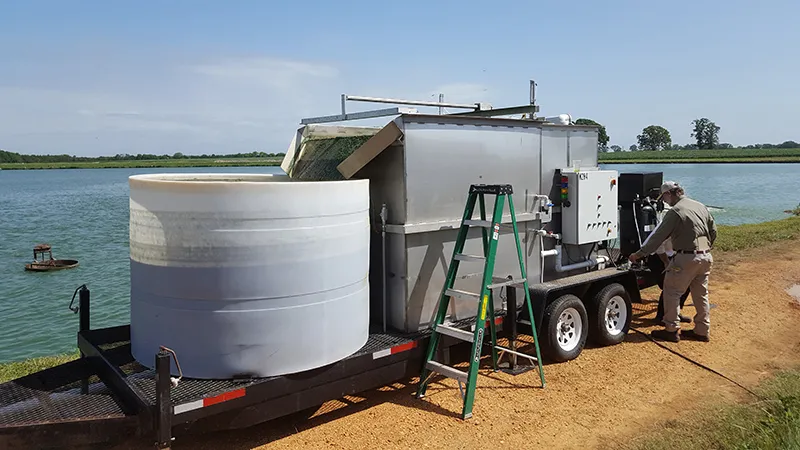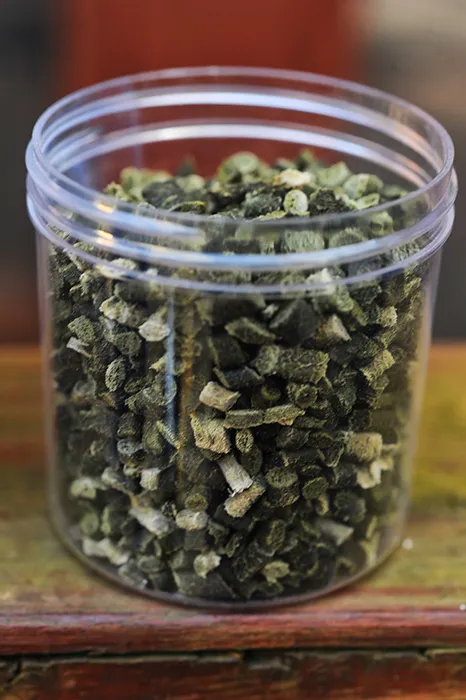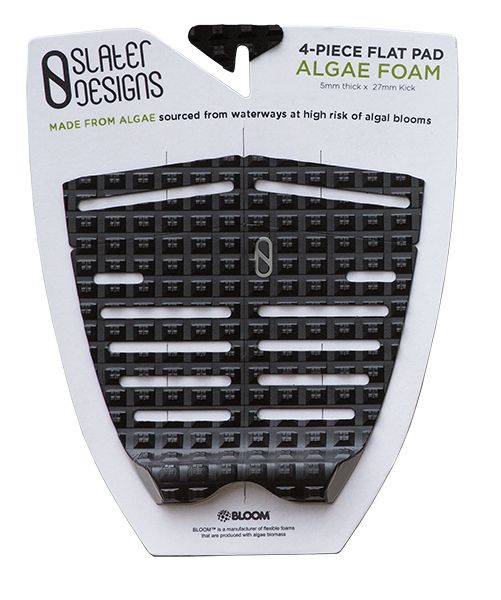This Startup Is Harvesting Wild Algae to Make Your Next Pair of Sneakers
Co-founder Rob Falken found a way to turn algae into a foam that can be used in sneaker soles and on surfboards
/https://tf-cmsv2-smithsonianmag-media.s3.amazonaws.com/filer/4b/4d/4b4d22c7-dca1-49c0-85c0-56a03a791e1c/bloom-pondwater_before_and_after.jpg)
Rob Falken is an inventor with a mission: to put the planet first in everything he does. He grew up in Southern California and calls surfing “the lifeblood of my youth.” The sport, he says, made him sensitive to the natural world.
Falken began inventing surf-related products when he was 17, making a surfboard wax at his mother’s kitchen table. Since then, the material designer has developed products, including skateboards made from reclaimed wood, a biodegradable surfboard with a foam base derived from sugar cane plants, and a buoyant foam used in lightweight life vests used by tow-in, big-wave surfers.
In 2014, Falken found himself wanting to focus on the kind of flexible foam you typically associate with yoga mats and the soles of running shoes. Only he wanted to do it in a sustainable way, putting an abundant form of refuse to good use.
Toxic blue-green algae, which is also known as cyanobacteria, has reached epidemic levels in recent years, due to rising global temperatures, as well as runoff and waterway contamination from human processes such as large-scale agriculture and sanitation. In the oceans, large-scale algal blooms are often dubbed “red tides” due to the rusty hue of the algae. They impact everything from the health of marine mammals, such as manatees, to the business of commercial fishers and seaside resorts where guests expect pristine beaches and clear water.
With algal blooms, a toxin called domoic acid accumulates in shellfish and marine fish stocks, such as anchovies and sardines. When those fish are consumed by other marine life, domoic acid causes a devastating domino effect across the food web. For months last winter, blooms halted California’s Dungeness and rock crab season, costing crabbers an estimated $48 million. The same season, Washington State’s Department of Fish and Wildlife curtailed razor clamming due to elevated levels of domoic acid present in the bivalves.
After a month of experimenting, Falken found a way to make algae his primary ingredient. He quickly co-founded Bloom, a company that now manufactures the foam product.

Bloom’s mobile harvester collects algae biomass from waste streams in the United States and Asia, harvesting the explosive plant life that clogs waterways and saps water of oxygen that aquatic life so desperately needs. After converting the harvested algae into a polymer, Bloom can produce all sorts of foam-based products, from sneaker soles and car seat upholstery to surfboard traction pads. The algae foam traction pad is Bloom’s first commercial product, made by surfer Kelly Slater’s design firm.
Falken, now Bloom’s managing director, spoke with Smithsonian.com about his algae-harvesting solution.
How did the idea for Bloom come about?
I got interested in this because I have a background developing materials with an environmental focus. I found out that for algae blooms, the past three years have been the worst three years ever, compounding on one another. I’m not exaggerating when I say this is a crisis. Over the July 4th weekend in Florida, the state lost millions in tourism dollars.
Plus, there are areas where the oxygen levels in the water are so depleted that there are manta ray mass die-offs. Manatees are dying from eating contaminated algae. These algae blooms are also bad for human health, impacting entire water systems that drain to the ocean from inland areas where there is massive cattle farming and sugarcane plant runoff.
So to circle back, in early 2014, I set out on a path to foam algae. Algae has been talked about a lot for biofuels, but to make biofuels, you need to genetically engineer enough materials, or basically grow it all in a lab. I tried to work with a bioplastics company already doing something similar to what I wanted to achieve, but the company, Cereplast, unfortunately went bankrupt before we could get our project off the ground.
I found another partner in the company Algix, which had simple but remarkable mobile algae harvesting systems that were successfully deployed to catfish farms throughout the South. Some of the harvesting systems were either underutilized or mothballed. I told them I had an idea to foam their material, and initially, they said it wouldn't work. But they sent me their materials to my specs, and after tinkering for just 30 days, I had a foam product. A few months later, Algix and my company Effekt joined to form Bloom.
How do you make your foam? How does your algae harvester work?
In general, we work with any type of blue-green algae. Blue-green algae is a polymer, so we basically vacuum it off a lake and dry it using our continuous solar drying process. Solar drying produces a charcoal-like flake, which we pulverize into powder. Once we have a pure powder—ours has no toxins—we make it into what is essentially a pellet, which we injection-mold into a panel and make a fiber out of it. We can dry anything with 40-plus percent protein content because that protein makes the plastic.

We really focus on the plastic side. Plastic is a chain of amino acids, which is the definition of a protein. We have a perfect solution that requires no arable land, no pesticides to grow, and a never-ending feedstock. We’re for profit, but we’re trying to make better solutions that put the planet first.
Can Bloom harvest from any body of water or just freshwater lakes and ponds?
We focus on polymerizing, and if we’re working with saltwater algae, salt creates a challenge when converting to polymer. That said, our system doesn’t care of its working in salt or fresh water, or algae thick as cake. Algae is the largest carbon dioxide sink on the planet; we can use it all. We can roll our mobile harvesters up to brackish estuaries or pontoon them onto the ocean. As Algix found at those catfish farms, we can get into delicate habitats with no harm to the environment.
How is Bloom different from other solutions trying to combat toxic algae blooms?
There is no other solution—not like ours. One of the only things you can do in an ocean or lake is dump in copper sulfate and kill everything.
Our harvester uses a giant vacuum with a screen, which prevents fish and aquatic life from getting sucked up. Then 99 percent of filtered water goes back, and we’re left with blue-green algae we can dry and use to make foam.

What can you make with your foam?
Surfers can use our foam for traction, and that’s how we ended up with our first major product, a four-piece flat pad for surfers to get better grip on their boards.
Do you have any patents for Bloom?
We have a patent on processing the polymers from algae. We also have 12 more patents in process, including some focusing on anti-microbial uses for our foam.
What’s next for Bloom?
Algix and Bloom’s mantra is to do the least amount of harm. We have really amazing technology and it is infinitely scalable because there is endless algae.
We project our foam will be in over two million pairs of shoes by early 2017 and 100 million pairs of shoes by 2018.
We think the consumer product category is easy because people like something they can buy; we’re making physical products people can connect with and use in their everyday lives. We can’t convert everybody to care about eco-friendly materials or products, but our material works.
/https://tf-cmsv2-smithsonianmag-media.s3.amazonaws.com/accounts/headshot/brittany_headshot_crop.jpg)
/https://tf-cmsv2-smithsonianmag-media.s3.amazonaws.com/accounts/headshot/brittany_headshot_crop.jpg)